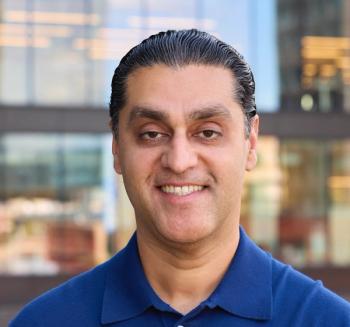
Gerald Harmon, AMA president, talks with National Press Club: Highlights
The leader of the American Medical Association said it’s time for a more robust healthcare system, telehealth reform and a larger, more diverse workforce.
Gerald Harmon, president of the American Medical Association, hopes to build a more robust healthcare system able to deal with future pandemics.
Harmon spoke in an online forum with the National Press Club Thursday. The event came two years after the first known COVID-19 death was reported in the United States. Harmon outlined the toll on the country, healthcare workers who have been “under siege,” and the steps needed to improve the system.
Harmon said he’s not sure what the future healthcare system looks like, but he said, “It can’t look like it does now.”
Harmon outlined key priorities to strengthen the healthcare system and steps to rebuild trust in medicine and science. Here are the highlights.
Build up stockpiles
The nation’s stockpile of essential medical supplies needs to be more robust, Harmon said. He said America needs greater domestic manufacturing capacity to quickly accelerate production of supplies such as personal protective equipment. The healthcare system faced significant shortages of masks, gloves and even basic items such as cotton testing swabs, Harmon said.
He called for more funding for pandemic preparedness; uneven use of federal authority for masks, testing and supplies; mixed messaging. He cited the inadequate response to the Omicron surge and the lack of testing materials 18 months into the pandemic.
Improve public health
State public health spending has dropped over the past decade, Harmon said. He said there needs to be more federal and state aid to improve a “diminished public health infrastructure.”
“A robust public health infrastructure is our nation's best defense against infectious disease,” he said.
Harmon was asked if it’s time to tear down the public health system and start from scratch. He said he didn’t think that would be practical but said “we need to fertilize that field.”
“It has to be resourced, it has to be prepared,” he said.
Learn from vaccine development
Harmon said the swift rollout of the COVID-19 vaccines was a remarkable feat that should be emulated in the future.
“Operation Warp Speed is quite simply one of the greatest scientific achievements of our lifetime,” he said.
When America essentially shut down in March 2020, Harmon said doctors knew little about the coronavirus.
“We didn’t have any treatments. We didn’t have any diagnostic testing. By the end of that year, I was vaccinated,” he said, adding, “I’m thinking that’s a minor miracle.”
The development of the vaccines happened so quickly because the administrative bureaucracy was compressed, he said.
Telehealth reform
Telehealth “has been a lifeline during the pandemic,” Harmon said.
The AMA, along with many other healthcare advocates, are pressing Congress and the Biden administration to make telehealth reforms permanent. He said the AMA is backing
Hosts of health and business groups are also pressing federal and state leaders on telehealth reform.
Taking care of healthcare workers
Doctors and nurses have endured not only the stress of caring for COVID-19 patients but harassment and even attacks. “This can’t be our future and shouldn’t be our present,” he said.
Harmon called for more attention to be placed on the mental health of healthcare workers. He hailed the passage of the
Harmon said such steps are long overdue. He cited a study that found
He also said it’s critical to ease some of the administrative burdens that are adding to burnout and driving some from the profession.
Expanding the pool
The nation needs more doctors and nurses, and he said the
“Our nation needs a hard reset in how we nurture and grow our physician community,” Harmon said.
The government needs to fund more slots for graduate medical education, he said. Harmon also called for eliminating barriers for those who want to become doctors, and the exorbitant costs must be addressed, he said.
The average physician leaves medical school with nearly $200,000 in debt, Harmon said. The high cost deters some from entering the field. The heavy debt also drives some doctors to work in larger cities where they can earn more to repay those loans. Consequently, fewer want to practice in rural areas.
While 1 in 3 people come from historically marginalized communities, he noted fewer than 1 in 8 doctors come from such communities. “This has to change,” Harmon said.
The nation needs “a physician community that better reflects the growing diversity of our patients,” Harmon said.
Rebuilding trust
Too many question the need for COVID-19 vaccines or the expertise of doctors and federal health officials. Harmon said healthcare leaders must address “the pandemic of mistrust.”
“This pandemic of mistrust was probably coming before COVID-19 but the extreme polarization in this crisis has profoundly hampered this nation’s ability to respond,” he said.
He also faulted the small number of doctors who spread misinformation and intentionally misrepresent health data. “They violate the ethics of our profession,” Harmon said.
The AMA has called on state licensing boards to take action against doctors who have spread false information. Harmon said boards don’t need to revoke licenses but must hold those willfully spreading false information accountable.
Federal officials also need to be mindful of restoring the public’s trust, including the U.S. Centers for Disease Control and Prevention. “The CDC needs to be more consistent,” he said.
The AMA and others criticized the CDC when the agency
Still, he praised the CDC’s research and said he has trust in the agency. He said the CDC needs to demonstrate its competence in its guidance. “If they continue to do the right thing, they’ll gain trust,” he said.
Lessons from a general
Harmon served in the Air Force Reserve and retired from military service as a major general. He cited his experience as a doctor and a veteran with experience in physical and emotional trauma.
“Our nation is suffering a type of battle fatigue from our long fight with COVID,” Harmon said. He said it’s likely the full scope of the trauma won’t be realized until the pandemic ends.
While he said COVID-19 will be part of life “for the foreseeable future,” the pandemic will end. And he said it’s critical to build a healthcare system that’s accessible to everyone and more flexible and effective in crisis response.
He cited the words of Joseph Warren, a military leader in the Revolutionary War who was also a doctor.
“Now it’s time to act worthy of ourselves,” Harmon said.





























































































